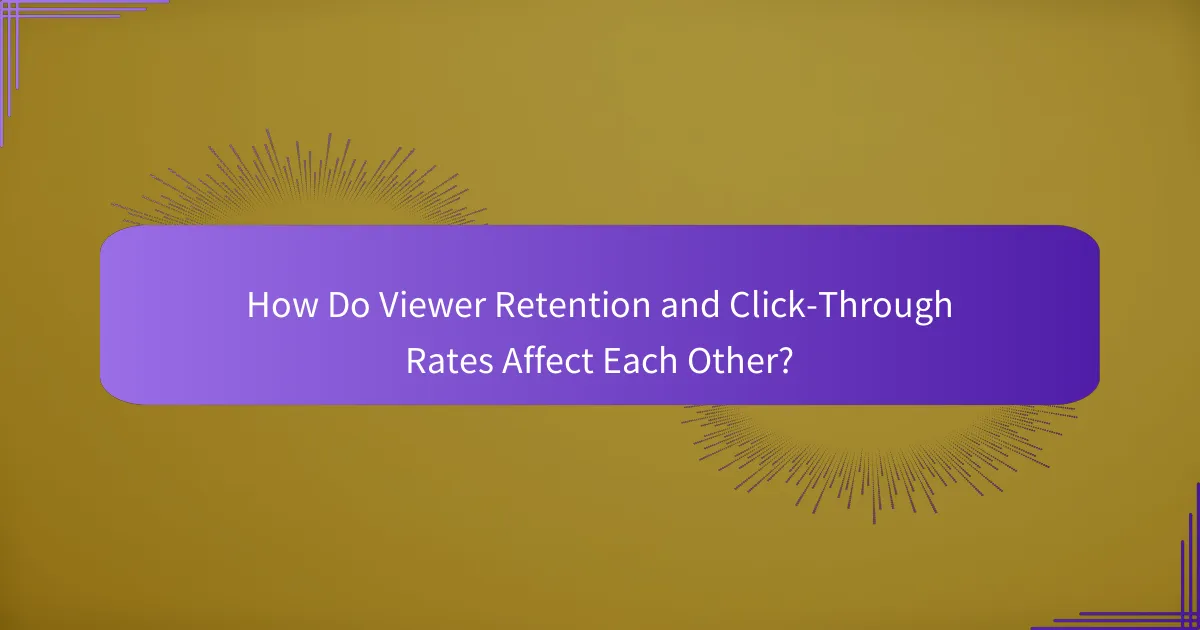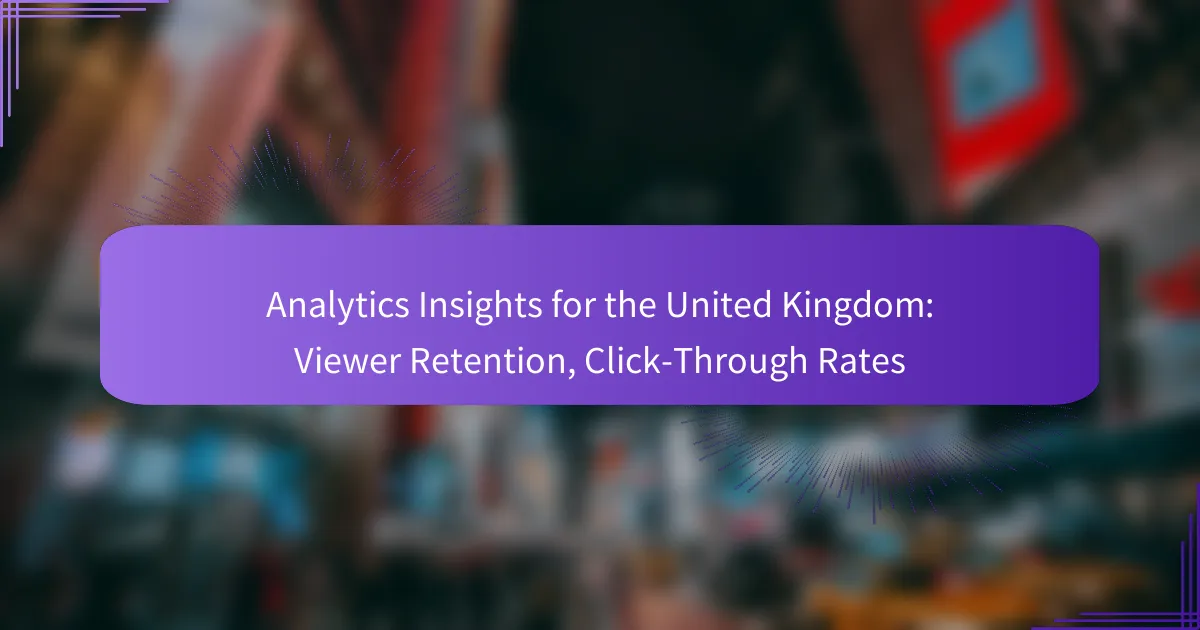In the competitive landscape of digital content in the United Kingdom, understanding viewer retention and click-through rates is crucial for success. By analysing metrics such as average watch time and engagement rates, creators can identify effective strategies to keep audiences engaged. Additionally, optimising content visibility and appeal can significantly enhance click-through rates, driving more interactions with links and advertisements.

How to Improve Viewer Retention in the United Kingdom?
Improving viewer retention in the United Kingdom involves creating engaging content and understanding audience preferences. By focusing on targeted strategies and interactive features, you can significantly enhance the likelihood that viewers will stay engaged with your material.
Utilise Targeted Content Strategies
Targeted content strategies are essential for retaining viewers. This means tailoring your content to meet the specific interests and needs of your audience. For example, using data analytics to identify trending topics can help you create relevant videos or articles that resonate with viewers.
Consider segmenting your audience based on demographics or viewing habits. This allows you to deliver personalised content, which can lead to higher engagement rates. Aim for content that speaks directly to your audience’s preferences, whether that’s through niche topics or localised themes.
Implement Interactive Features
Interactive features can significantly boost viewer retention by encouraging active participation. Incorporating polls, quizzes, or live Q&A sessions can make your content more engaging. For instance, during a live stream, asking viewers to vote on what topic to discuss next can keep them invested.
Additionally, consider adding comment sections or forums where viewers can discuss content. This not only fosters community but also keeps viewers returning to engage with both the content and each other.
Analyse Audience Behaviour Patterns
Understanding audience behaviour patterns is crucial for improving retention. Utilise analytics tools to track metrics such as average watch time, drop-off points, and viewer demographics. This data can reveal what content keeps viewers engaged and what causes them to leave.
Regularly reviewing these patterns allows you to adjust your content strategy accordingly. For example, if you notice viewers drop off after a certain point, consider revising that section to make it more compelling or concise. Adapting to these insights can lead to a more loyal viewer base over time.

What Are Effective Click-Through Rate Strategies?
Effective click-through rate (CTR) strategies focus on optimising elements that encourage users to engage with content. By enhancing visibility and appeal, these strategies can significantly boost the likelihood of users clicking on links or advertisements.
Optimise Call-to-Action Placement
Strategically placing call-to-action (CTA) buttons can greatly influence CTR. Position CTAs above the fold, where users can easily see them without scrolling, and consider using contrasting colours to make them stand out.
Experiment with different placements, such as at the end of articles or in pop-ups, to determine what works best for your audience. A/B testing can help identify the most effective locations and designs.
Enhance Visual Appeal of Thumbnails
Thumbnails serve as the first impression of your content, making their visual appeal crucial for attracting clicks. Use high-quality images, bold colours, and clear text overlays to capture attention.
Consider the context of your audience when designing thumbnails. For example, a vibrant and playful design may work well for a younger demographic, while a more professional look may appeal to business professionals.
Test Different Headlines
Headlines are pivotal in driving clicks, so testing various options can yield significant improvements in CTR. Use action-oriented language and incorporate numbers or questions to pique curiosity.
Monitor the performance of different headlines over time to see which resonate best with your audience. Tools like headline analyzers can provide insights into the effectiveness of your choices.

What Metrics Should Be Tracked for Viewer Retention?
To effectively measure viewer retention, focus on metrics like average watch time, drop-off rates, and engagement rates. These indicators provide insights into how well content holds the audience’s attention and where improvements can be made.
Average Watch Time
Average watch time is the total viewing duration divided by the number of views, reflecting how long viewers stay engaged with your content. A higher average watch time suggests that your material is resonating well with the audience. Aim for a target that aligns with your content type; for instance, videos should ideally keep viewers engaged for several minutes.
To improve average watch time, consider optimising video length and pacing. Shorter, focused content often performs better, especially on platforms like YouTube, where viewer attention can wane quickly. Regularly analyse your watch time data to identify patterns and adjust your content strategy accordingly.
Drop-Off Rates
Drop-off rates indicate the percentage of viewers who stop watching at specific points in your content. Monitoring these rates helps identify where viewers lose interest, allowing for targeted improvements. A drop-off rate of over 30% at any segment may signal a need to revise that portion of the content.
To reduce drop-off rates, ensure that your content maintains a strong hook in the opening moments and delivers value consistently throughout. Use analytics tools to pinpoint exact moments where viewers disengage and experiment with different formats or styles to retain their attention.
Engagement Rate
Engagement rate measures how actively viewers interact with your content, typically calculated through likes, shares, comments, and click-throughs. A higher engagement rate indicates that viewers are not only watching but also connecting with your content. Aim for engagement rates of at least 5-10% for effective audience interaction.
To boost engagement, encourage viewer interaction by asking questions or prompting comments. Incorporating calls to action can also enhance viewer participation. Regularly review engagement metrics to refine your approach and foster a more interactive viewer experience.

What Metrics Should Be Tracked for Click-Through Rates?
To effectively analyse click-through rates (CTR), focus on three key metrics: click-through rate percentage, impressions count, and conversion rates. These metrics provide insights into how well your content engages viewers and drives them to take action.
Click-Through Rate Percentage
The click-through rate percentage is calculated by dividing the number of clicks by the number of impressions, then multiplying by 100. A higher CTR indicates that your content is compelling and relevant to your audience.
For most industries, a CTR in the low single digits is common, while exceptional campaigns may achieve rates in the double digits. Regularly monitor this metric to identify trends and optimise your content accordingly.
Impressions Count
Impressions count refers to the total number of times your content is displayed to users. This metric is crucial as it provides context for your CTR; a high CTR with low impressions may not be as impactful as a moderate CTR with high impressions.
To improve impressions, consider enhancing your SEO strategies, utilising social media promotions, or investing in paid advertising. Aim for a balance between impressions and engagement to maximise your reach.
Conversion Rates
Conversion rates measure the percentage of users who take a desired action after clicking through, such as making a purchase or signing up for a newsletter. This metric is vital for assessing the effectiveness of your content in driving results.
Typical conversion rates can vary widely, often ranging from 1% to 5% depending on the industry and the specific action. To enhance conversion rates, ensure your landing pages are optimised for user experience and clearly convey value to potential customers.

How Do Viewer Retention and Click-Through Rates Affect Each Other?
Viewer retention and click-through rates (CTR) are closely linked; high retention often leads to improved CTR. When viewers stay engaged with content, they are more likely to click on additional links or ads, enhancing overall performance.
Correlation Between Engagement and Retention
Engagement is a key driver of viewer retention. When content is compelling, viewers are more inclined to stay longer, which positively influences their likelihood to click on related content. For instance, videos that maintain viewer interest for several minutes typically see higher CTRs compared to those with rapid drop-offs.
To enhance engagement, consider using interactive elements like polls or quizzes that encourage viewers to participate actively. This strategy can significantly boost both retention and CTR, leading to a more successful content strategy.
Impact on Overall Performance Metrics
High viewer retention rates can lead to improved overall performance metrics, such as increased revenue from ads and higher conversion rates. For example, content that retains viewers for longer periods can see CTRs rise by double digits, translating to more effective monetisation strategies.
To maximise these metrics, focus on creating quality content that resonates with your audience. Regularly analyse viewer behaviour to identify what keeps them engaged, and adjust your content strategy accordingly to maintain high retention and CTR levels.

What Tools Can Help Analyse Viewer Retention?
Several tools can effectively analyse viewer retention, providing insights into how well content keeps audiences engaged. Utilising these tools can help identify trends, optimise content strategies, and improve overall viewer satisfaction.
Google Analytics
Google Analytics is a powerful tool for tracking viewer retention metrics, including session duration and bounce rates. By setting up goals and events, you can monitor how users interact with your content over time.
To get started, create segments for different user groups, such as new versus returning visitors. This allows for a more nuanced understanding of retention patterns. Regularly check the Audience Overview and Behaviour Flow reports to identify drop-off points in your content.
Mixpanel
Mixpanel focuses on user behaviour analytics, making it ideal for analysing viewer retention through event tracking. It provides detailed insights into how users engage with specific features or content, allowing for targeted improvements.
Utilise Mixpanel’s cohort analysis to compare retention rates among different user segments. This can help you identify which content types or features keep users coming back. Consider setting up automated notifications for significant changes in retention metrics.
Hotjar
Hotjar offers qualitative insights into viewer retention through heatmaps and session recordings. These features allow you to visualise how users interact with your content, highlighting areas that may need improvement.
To make the most of Hotjar, combine heatmaps with user feedback tools like surveys. This can provide context to retention data, helping you understand why viewers may leave or stay. Regularly review this data to adapt your content strategy based on user behaviour.

What Tools Can Help Analyse Click-Through Rates?
To effectively analyse click-through rates (CTR), various tools can provide valuable insights into user engagement and behaviour. These tools help marketers understand how well their content is performing and identify areas for improvement.
Google Analytics
Google Analytics is a powerful tool for tracking CTR across different platforms. It allows users to monitor website traffic, user behaviour, and conversion rates. By setting up goals and tracking events, marketers can gain insights into which pages or campaigns are driving clicks.
To optimise CTR using Google Analytics, focus on the “Acquisition” reports to see where your traffic is coming from. Regularly review the “Behaviour Flow” to understand how users navigate your site and identify potential drop-off points.
Hotjar
Hotjar provides heatmaps and session recordings that help visualise user interactions on your website. This tool allows you to see where users click most frequently and how they scroll through your pages. Understanding these patterns can inform design changes to improve CTR.
Utilise Hotjar’s feedback polls to gather user opinions on why they may not be clicking on certain elements. This qualitative data can complement quantitative metrics, providing a fuller picture of user engagement.
SEMrush
SEMrush offers comprehensive analytics for SEO and PPC campaigns, making it easier to analyse CTR across different channels. This tool provides insights into keyword performance and competitor strategies, helping you refine your approach.
To enhance CTR with SEMrush, regularly audit your ad copy and landing pages. Look for high-impression keywords with low CTR and adjust your content to better align with user intent.
Mailchimp
For email marketing campaigns, Mailchimp is a go-to tool for analysing CTR. It provides detailed reports on how recipients interact with your emails, including open rates and click rates for specific links.
To improve email CTR, experiment with different subject lines and call-to-action buttons. A/B testing can help identify which elements resonate best with your audience, leading to higher engagement rates.
